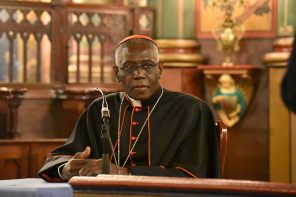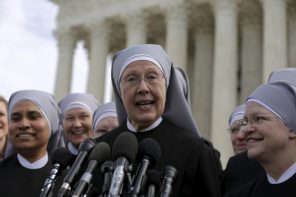A Pilgrim in a Pilgrim Church: Memoirs of a Catholic Archbishop
Rembert Weakland
(William B. Eerdmans Publishing Co. 2009)
I begin by confessing that I do not read books about men’s lives very often, figuring I learn enough about them from the stream of information that comes to me through news and media. What time I have for such reading I usually save for books about women. But if I had passed over Rembert Weakland’s autobiography, I would have missed a marvelous read; it is at once a crash course on monastic life, a record of inside stories of Vatican dealings, and insights into the struggles of some church officials to reconcile conscience with reality. It is about one man’s personal journey from working class Pennsylvania to the heights of ecclesial power. But it is also about the kind of scandal, moral and social, that can unmake a career.
Reading Weakland’s account in the weeks after Senator Kennedy’s death, I could not help but make a connection between them: Weakland, like Kennedy, lived in the fishbowl of public scrutiny, and knew from experience both the pain of scandal and the solace of a religious tradition that includes repentance and forgiveness.
Good Training for Being Pope
Rembert Weakland, born in 1927, is a Benedictine monk, a retired Archbishop of Milwaukee, an accomplished musician, and a Catholic progressive who surveys his remarkable life in a compelling fashion. His early experience of going to a Benedictine monastery high school set him on a trajectory for quality education and religious leadership. Study in Rome and the chance to live there with confreres from around the world kept him learning languages and incorporating different cultural realities at a time when most Americans were just as monolingual and xenophobic as Europeans thought they were.
He was elected to lead his abbey in Latrobe, Pennsylvania, at the age of 36; and was tapped as abbot primate of the Benedictines worldwide at 40. He engaged the task vigorously in a distinguished way, traveling the world to learn from and network with people virtually everywhere. I got winded just reading about his nearly 600 visits to Benedictine houses of men and women outside of Rome by the end of his tenure in 1973. It was an exhaustive (and likely exhausting) tour of the world that took him to remote parts of Africa and Eastern Europe, all over Latin America, as well as throughout Western Europe, Asia, North America, and Australia. It read like good training for being Pope, if you ask me.
Weakland was a contemporary and friend of the Jesuit’s beloved leader Pedro Arrupe. It was Rembert Weakland who gave Thomas Merton’s still-warm body the last rites when he died in Thailand. Benedictine life obviously agreed with him since it allowed him a long leash and many short ties to a worldwide community of which each individual house is a unique part.
Abbott Weakland knew his way around the Vatican under Pope Paul VI, when he had friends in high places and a good rapport with the pontiff. That all changed under Pope John Paul II, and the rest, as they say, is history. Weakland eventually became persona non grata in the very places where he had been heavily involved, especially in liturgical circles. Changes in the papacy cause a ripple effect throughout Vatican offices. Theopolitics is nasty, rather like watching the law (or maybe sausage) being made—better not to get too close.
I came away with a strong sense of just how personal (not to say petty) a lot of the Vatican workings are—who knows who and what squeaky wheel gets grease. It obviously cuts both ways, and you’re out as fast as you’re in. It’s a bit like Washington’s two-party system the way that Republican appointees leave when the Democrats are elected and vice versa. Structural work to minimize such capricious power in the Church is an urgent priority. Weakland emphasized that in his ultimately unsuccessful insistence on the power of national bishops’ conferences instead of the unfettered power of the curia; the effort was part of his undoing.
Although he didn’t think so, I sense that his appointment as ordinary in Milwaukee was a way to get him out of the Vatican’s hair in his role as advocate for Church change via a religious order. As head of the Benedictines, Weakland was in a strong position to raise tough issues. But for whatever reason, he served as Milwaukee’s bishop for two decades in an ethnically diverse and theologically challenging city. His efforts at liturgical reform, participatory development of ideas and policies, and inclusion of women and lay men in the running of the diocese were simply more than the right wing could stand. He was thwarted at several turns, vilified for his renovations of the local cathedral, and condemned for his pastoral efforts to listen to women’s accounts of their experiences of abortion.
With his retirement came the end of an era when even a handful of bishops had the gumption to meet outside of officialdom and try to effect change from within the hierarchy. Alas, we will not see his like soon in the American episcopacy, as the current appointees are by and large conservative company men who have been well vetted on questions of abortion, homosexuality, and women’s ordination to make sure they toe the line.
Consensual, Legal, But Still Out of Bounds
Memoirs are tricky literary business. This one is no exception. The opening and closing pieces deal with what was undoubtedly Weakland’s most difficult personal experience, the aftermath of a 1979 sexual liaison with a man in his thirties, Paul Marcoux. In 1997, Marcoux initiated legal proceedings against the Archbishop for what he called sexual abuse, holding a 1980 letter that Weakland had written as a kind of ransom for the million dollars he wanted. When that did not work, he claimed that the Archbishop had thwarted his efforts to advance professionally with a religious drama program he tried to develop. He still wanted money.
It was a trying time for Weakland, who countered that the sexual activity was consensual and legal (unlike the pedophilia cases that cascaded in the ensuing years). But the threat of public exposure, the potential damage to the institutional Church and to his own reputation, led him to authorize $450,000 of what was in fact Church money to pay off Marcoux. Add that to legal fees and we’re talking real money. Some years later, Marcoux made the whole thing public. Let me repeat, religion can be a nasty business.
Scholars will ponder this chapter of Church history for generations to come. My analysis is contemporary with the facts so fraught with an up-closeness that can lead to its own distortions. But as I see it, Rembert Weakland was a product of the very ecclesial problems he sought to overcome. He was a gay man in a homosocial hierarchy who claims he knew little about his own sexuality until he was 40. He was part of an institution that kept the voices of women and same-sex lovers from ever being heard in places where they could make a difference to doctrine, ethics, and/or pastoral practice. He lived as a vowed celibate man at some remove from the movements of women and same-sex lovers from whom he might have gotten more clues about how to be part of a Church that does justice. He immersed himself in the work of the institutional Church without the balance all of us need that comes mainly from friends who keep us grounded. These are not excuses but sad facts.
What is missing, of course, is the story from Paul Marcoux’s side. And perhaps there were other men as well; all of which is to say that human beings are sexual. What remains tragically perplexing is why someone in Weakland’s position would be so unaware of, or unconcerned about, his own power in an intimate relationship even if it were legal. After all, it is not everyone who has sex with a bishop or the abbot primate! Would that he had read Marie M. Fortune’s signal work on clergy sexual abuse and realized that the sheep are off limits to the shepherd. This is not simply because of a celibate commitment or a vow of chastity, but because power inequalities between clergy and laity make authentic consent iffy. Persons in clergy roles have special responsibility that comes with the territory to acquit themselves sexually in ways that are professionally appropriate. Happily we have more insight into these issues now, but that does not change the past.
Archbishop Weakland reverted to type in his moment of need. A loyal (if on this occasion uncritical) churchman, he took the advice of those who thought first of the “good of the church” and not the needs of the victims. He was oblivious to the power of his position, title, and role; something that no professional can excuse. He used resources that belonged to the whole community for his own protection. That, too, comes with no excuse and the obligation to repay as much as possible. But it is over and done with, and his public confession, instant retirement, and subsequent withdrawal from the public scene are only the tip of the iceberg of this man’s penance.
He writes little about being gay. But I wonder how different things would have been if Paul had been Paula. I wonder, too, if his self-described lack of sexual self-awareness was a product of living in a homosocial world such that he didn’t need to differentiate himself over against it. He does not describe other sexual opportunities, but one hopes in 80 years that there were some! The problem with vows of chastity, commitments to celibacy, is that normal sexual aspects of life are off limits to conversation except in the most privileged of settings (spiritual direction or as part of the sacrament of penance), so they are not integrated into a healthy life. After all, one can always say no to an offer for sex. But not having close friends, not having sex come up as a possibility, strikes me as a sad lacuna in an otherwise brilliant life. I can only hope that the author withheld a bit.
I admire the fact that Rembert Weakland tells his story without self-pity, with more humility than most in his place ever exhibit, and with a transparent love for the institution and its people that was finally his undoing. He does it with a kind word for all including the most hard-to-love characters he encountered with an even-handedness that I envy.
I was relieved to read that he turned the same love and care on himself, obviously the fruit of some good therapy and spiritual direction. He never excused what he considered a lapse of judgment brought on by loneliness in the face of loss (his mother’s death, the death of Paul VI whom he held as a father figure, etc.). By writing his whole life’s story, albeit with the sexual failing as bookends to the rest, Weakland signals that he, too, is able to put the public scandal into perspective. I wonder how I would feel if he had been a conservative bishop. But I like to think that there is something to the matter of forgiveness and to seeing lives as wholes, rather than parts, that transcends all that.
I learned a lot from this book. Beyond the facts about monasticism and the glimpses into the internal workings of the Roman Catholic Church, I learned about one gay man’s efforts to live with integrity against formidable odds. That Rembert Weakland can say he is “at peace with my God, with my Church, and with myself” may cause some people to say that he shouldn’t be. Such judgments are well beyond the pay grade of anyone I know. The record of a life well lived stands on its own, as Archbishop Weakland proves in this compelling book. Now an octogenarian, I only hope he knows that he is well accompanied by the rest of us human beings.




